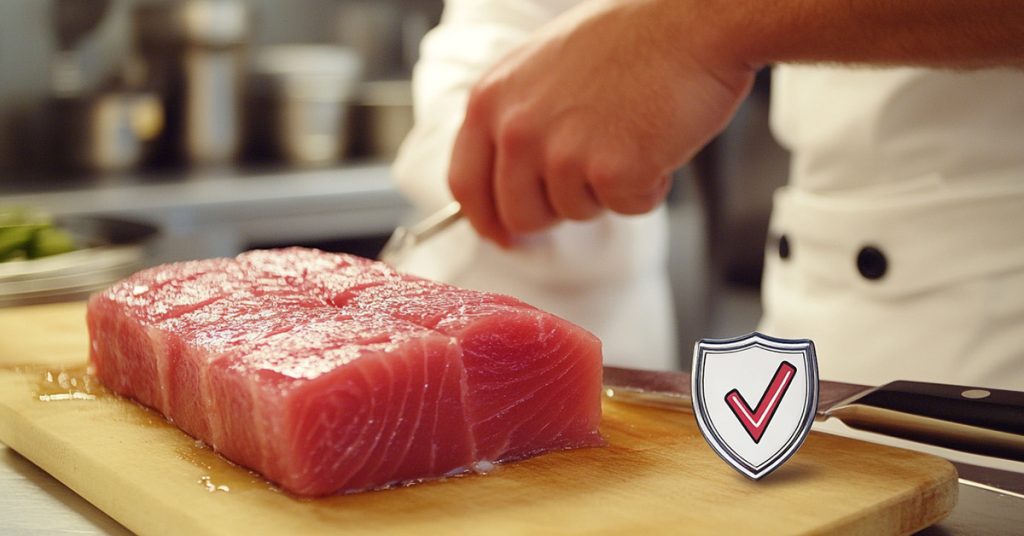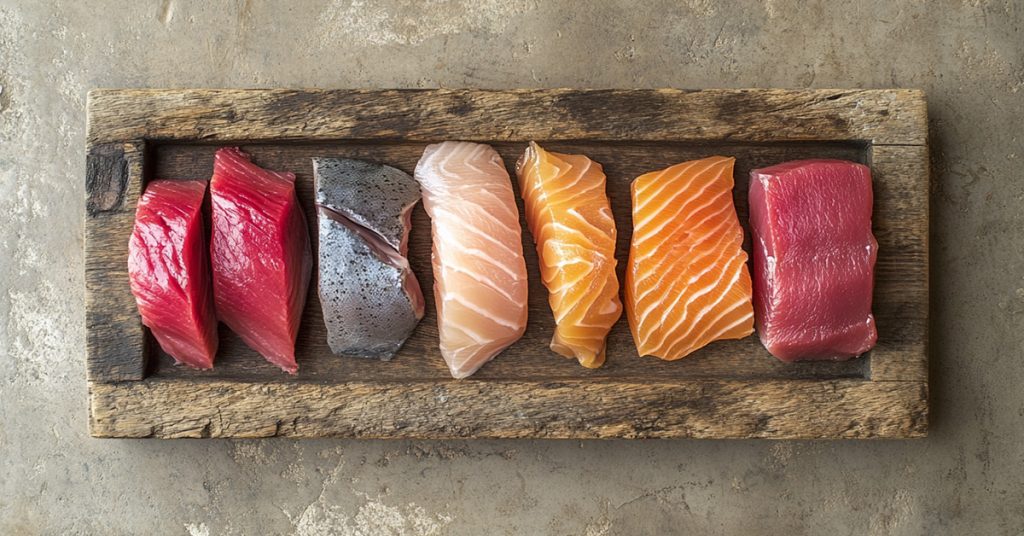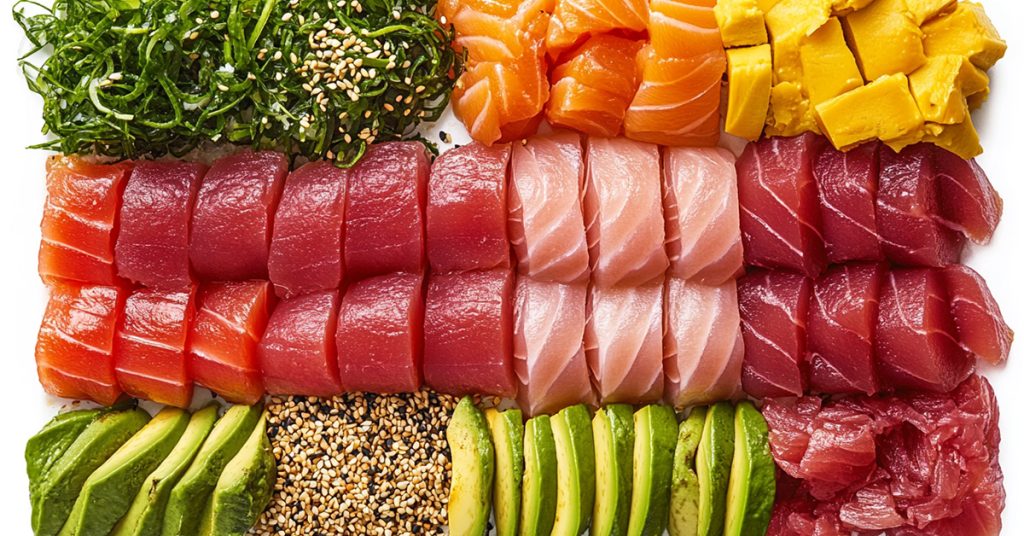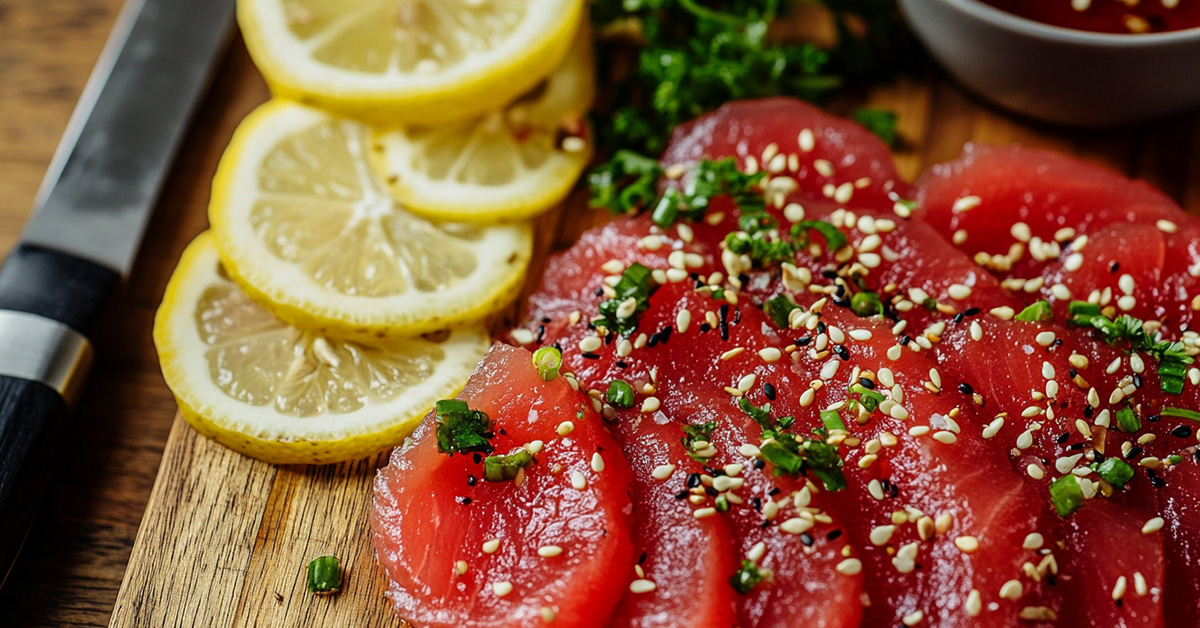Raw tuna ranks among the most popular fish at sushi restaurants worldwide. Many people ask a common question: can you eat tuna raw? The answer goes beyond a simple yes or no.
Raw tuna has become a cornerstone of Japanese cuisine. Its popularity continues to grow through dishes like poke bowls and tuna tartare. Safe consumption of raw tuna depends on proper knowledge and careful precautions. The right type of tuna selection and proper handling techniques determine whether eating raw tuna will be safe for you.
This complete guide will show you everything about eating raw tuna. You’ll learn about safety measures, health advantages, and ways to pick the finest quality fish that’s safe to eat raw. The information will help you decide if raw tuna belongs in your diet.
Table of Contents
Understanding Raw Tuna: What You Need to Know
Let’s explore what you should know about raw tuna’s safety and quality before taking your first bite. Raw tuna consumption brings three main concerns to the table:
- Bacterial contamination from improper handling.
- Parasitic infections.
- Mercury and other toxic substances.
The numbers about parasites in raw tuna might raise some eyebrows. Research reveals that 64% of young Pacific bluefin tuna samples from Japanese waters had parasites that could lead to food-related illness. The situation looks even more concerning in Iranian waters, where 89% of tuna samples contained parasites that could trigger stomach and intestinal problems.
But these statistics shouldn’t scare you away completely. The risk of food poisoning from properly handled raw tuna is nowhere near as high as you might think. Tokyo’s data shows that sushi restaurants make up less than 0.8% of total food poisoning cases7. This low rate stems from proper handling techniques and the natural antimicrobial properties in common sushi ingredients like soy sauce, salt, and vinegar.
Mercury poses its own set of challenges. It’s worth mentioning that this heavy metal doesn’t give itself away – you can’t see or smell it. Large tuna species such as albacore, yellowfin, bluefin, and bigeye accumulate higher mercury levels as they age. This becomes especially important if you’re pregnant or planning for pregnancy, since mercury can affect neurodevelopment.
The silver lining? Tuna stands out as one of the few fish species that rarely harbors parasites. Quality plays a substantial role here. Your raw tuna should always come from either fresh, high-quality fish or properly frozen catches. These careful handling practices drastically reduce any health risks tied to raw consumption.
Note that raw tuna can be safe to eat, but moderation makes all the difference. The CDC suggests keeping tuna meals to two servings weekly. This way, you get to enjoy tuna’s benefits while keeping potential risks at bay.
Is It Safe to Eat Raw Tuna? A Comprehensive Safety Breakdown

Raw tuna safety comes down to how you handle and prepare it. The FDA says cooking seafood is safest, but you can eat raw tuna safely if you follow specific guidelines.
The Freezing Factor The FDA says you should freeze raw tuna using one of these methods to kill parasites:
- At -4°F (-20°C) or below for 7 days.
- At -31°F (-35°C) or below until solid, then store at -31°F for 15 hours.
- At -31°F (-35°C) until solid, then store at -4°F for 24 hours.
Recent studies show some worrying numbers about parasites in raw tuna. Scientists found parasites that cause diarrhea in 64% of young Pacific bluefin tuna samples. Another study showed 89% of samples had parasites that could upset your stomach.
But here’s the good news: raw tuna is generally safe if handled correctly. Some larger tuna species don’t even need to meet the FDA’s freezing rules because they have such a strong safety record.
Who Should Exercise Caution? Raw tuna isn’t safe if you’re in these high-risk groups:
- Pregnant or breastfeeding women.
- Children under 5 or adults over 65.
- People with compromised immune systems.
- Those undergoing cancer treatment.
Finding a trustworthy supplier is vital when buying raw tuna. Look for firm flesh without fishy smells, and avoid any discolored or slimy pieces. Most reliable sushi restaurants and fish suppliers follow FDA freezing rules, making them safer choices for raw tuna.
Note that freezing kills parasites but doesn’t solve mercury issues. Bigger tuna species like albacore, yellowfin, and bluefin typically have higher mercury levels, so watch how often you eat them.
Parasites and Bacteria: What You Need to Watch Out For
Raw tuna comes with specific risks from parasites and bacteria that you need to know about to stay safe. A newer study, published in 64% of young Pacific bluefin tuna samples showed parasites that could make you sick.
The Anisakis Threat The Anisakis worm is a vital concern as this parasitic roundworm can cause severe infections. Raw fish infected with these worms can trigger several symptoms:
- Violent abdominal pain.
- Nausea and vomiting.
- Bowel issues.
- Abdominal inflammation.
Your risk level depends on where the tuna comes from and how it’s handled. Research on tuna from Iranian waters revealed a shocking 89% infection rate with parasites that can stick to your stomach and intestines. But proper handling reduces these risks by a lot.
Bacterial Concerns Bacteria pose another big risk. Raw tuna’s surface and juices can harbor bacteria that lead to foodborne illness. The good news? Traditional sushi preparation methods help curb bacterial growth naturally. Soy sauce, salt, and vinegar all work as natural antibacterial agents. That’s why sushi restaurants account for less than 0.8% of all food poisoning cases.
Cross-Contamination Risk Bacterial infection risks jump up through cross-contamination. You should follow strict food hygiene standards at home to stop bacteria from spreading. Use clean utensils, wash your hands really well, and disinfect all surfaces properly.
Note that while these risks exist, you can reduce them through proper handling and preparation. The secret lies in buying from trusted sources that follow FDA guidelines for killing parasites through freezing.
The Best Types of Tuna for Raw Consumption

The safe and enjoyable consumption of raw tuna depends on selecting the right type. Bluefin tuna reigns supreme as the most sought-after variety, and with good reason too – its rich, buttery texture and deep red flesh make it exceptional.
Raw tuna comes in several quality grades that buyers should know about:
- #1 Grade: The high fat content creates visible marbling with a sticky texture. Its red, shiny, translucent appearance makes it perfect for raw consumption.
- #2+ Grade: The meat has some fat content but remains leaner than #1. Its good color and brightness make it suitable for raw preparations.
- #2 Grade: This grade works best in cooked dishes rather than raw consumption.
Yellowfin tuna’s (Ahi) slightly milder flavor makes it a great starting point for raw tuna newcomers. The meat’s firm, tender texture adapts well to different preparations. People watching their mercury intake should note that Yellowfin contains about 0.35 ppm of mercury.
Albacore tuna stands out with its lighter color and subtle flavor profile. The soft, buttery texture appeals to people who prefer delicate tastes. This variety leads all tuna types in protein content while containing just 117 calories per 100 grams.
Japanese cuisine recognizes three premium cuts: Akami (lean, red meat from the sides), Chutoro (balanced mix of lean and fatty belly parts), and Otoro (the most luxurious fatty belly portion). Otoro’s 25-30% lipid content creates a melt-in-your-mouth experience.
Mercury levels vary between tuna species. Bluefin, despite being the most expensive, typically has the highest mercury content. People concerned about mercury should look at skipjack tuna as an alternative – it contains much lower levels at around 0.144 ppm.
Selecting the Perfect Tuna for Raw Preparation
Want to pick out the best raw tuna for your next meal? The secret is knowing what signs point to high-quality fish. The market or fish counter offers several important things to think about.
Let’s get into the color first. High-quality raw tuna should never have a glowing, plastic-like appearance or transparent red color. Any tuna that keeps an unusually bright color after freezing has likely undergone chemical treatment to hide its real freshness.
These quality indicators will help you make the right choice:
- Natural color progression (should brown slightly when frozen).
- Clean, oceanic scent without strong fishy odors.
- Firm, sticky texture with a natural-looking curve when balanced.
- Clear, bright appearance without dullness or dryness.
Quality comes at a price with genuine sushi-grade tuna. You’ll pay more because it needs quick air shipping and careful handling. To name just one example, see high-grade Bluefin tuna ranges from $30-60 per pound for Akami (lean meat) to $80-200 per pound for Otoro (fatty belly).
The bending test helps check freshness. Place the fish across your fingers in the middle – good tuna naturally curves. Stiff fish that resists bending probably contains ice crystals or too much moisture.
A word on sustainability: Yellowfin tuna makes a better choice than Bluefin. Global Bluefin populations have declined by a lot due to overfishing. Your choice of eco-friendly options supports responsible fishing and offers healthier meals.
Note that the FDA doesn’t regulate the term “sushi-grade”. Trust what your senses tell you and ask questions about where the fish comes from, how it’s handled, and storage conditions.
Nutritional Powerhouse: Health Benefits of Raw Tuna
Raw tuna’s nutritional benefits show why many people call it a true superfood. It packs essential nutrients while staying incredibly low in calories. This seafood adds smart health benefits to your diet.
Raw tuna gives your body a big protein boost. Just 2 ounces provide 13 grams of lean protein. The protein comes with only 70 calories per serving, which makes it perfect to maintain muscle mass and manage your weight.
Raw tuna stands out as a nutritional powerhouse because it contains:
- Rich in omega-3 fatty acids (DHA and EPA).
- Abundant in vitamins A, B2, B3, B6, B9, B12, and D.
- Packed with minerals including iron, zinc, calcium, magnesium, and selenium.
Weight Management Benefits: Studies show eating 4 ounces of tuna two to three times weekly helps with weight loss and reduces inflammation. The high protein content keeps you fuller longer and supports your weight management goals.
Raw tuna’s omega-3 fatty acids play a significant role in heart health. Studies link regular consumption with reduced rates of cardiovascular disease. Your eyes benefit too – research with 40,000 female health professionals showed multiple weekly tuna servings led to 68% lower risk of dry eye.
Nutritionists suggest eating 3-5 ounces of fish 2-3 times per week to get enough omega-3s. Note that you should balance these benefits with mercury awareness, especially if you’re pregnant or planning pregnancy.
Why Raw Tuna Might Be Better Than Cooked
Raw tuna has a special place in many seafood lovers’ hearts. The science explains why raw tuna tastes better, and it all comes down to its unique nutritional makeup and natural preservation.
Raw tuna contains an impressive 24.6% protein content and just 0.54% fat. This lean protein profile makes it a perfect choice if you want to eat healthy. Raw tuna’s natural state preserves its distinctive “marbleized” flesh structure that creates the melt-in-your-mouth texture you love in sushi and sashimi.
Raw tuna stands out because it:
- Keeps its meaty texture and mild, non-fishy flavor.
- Maintains its natural water content of 69.4%.
- Preserves maximum nutritional value without heat breaking it down.
- Keeps protein structure intact so your body absorbs it better.
Tuna’s swimming patterns and body structure create its amazing nutritional profile. The fish’s constant movement leads to well-oxygenated flesh, which creates that perfect balance of lean protein and essential fats. This explains why sushi restaurants worldwide value raw tuna so highly.
Studies back up the benefits of eating raw tuna. You can lose weight and reduce inflammation by eating just four ounces of tuna two to three times weekly. Raw and cooked tuna are both healthy, but eating it raw keeps all those delicate nutrients intact that make this fish so special.
You may like: Tuna Belly Recipe
Note that handling raw tuna properly is vital – it stays fresh at room temperature for only about 6 hours before it starts to spoil. You should eat it fresh or store it correctly to get the most benefits while staying safe.
Popular Raw Tuna Dishes from Around the World

Raw tuna has inspired countless culinary masterpieces worldwide. Japanese traditions and modern fusion dishes show amazing ways to enjoy this versatile fish.
Tuna Tartare shines in Japan with its elegant preparation that combines diced sushi-grade tuna with ginger oil, wasabi, and sesame seeds. Tomato and cilantro top this dish to create a perfect balance of flavors.
Italian Crudo brings a simpler yet equally sophisticated take on raw tuna. Sicily’s chefs slice tuna paper-thin and dress it with:
- Peppery olive oil.
- Lemon zest.
- Calabrian chili paste.
- Toasted fennel seeds.
- Flaky sea salt.
Peru’s Tiradito reflects Japanese immigrants’ influence on South American food. This dish features sashimi-style cuts in a vibrant sauce that blends lemon juice, orange juice, and ají amarillo chiles.
Hawaii’s favorite raw tuna dish is Poke. Modern versions use chunks of lean ahi (yellowfin) tuna with soy sauce, sesame oil, and sweet Maui onions. Hawaiian supermarket delis stock at least half a dozen different poke varieties.
Japanese Tataki bridges the gap between raw and cooked preparations. Chefs quickly sear tuna’s outside while keeping its interior raw, then coat it with furikake (Japanese rice seasoning). They serve it with a distinctive sauce made from Kewpie mayo and yuzu juice.
These dishes showcase simplicity and respect for their star ingredient. Raw tuna’s versatility makes it shine in cuisines worldwide, from traditional Japanese sashimi to modern fusion creations.
Beyond Sushi: Creative Raw Tuna Preparations
Raw tuna offers endless possibilities beyond traditional sushi. Your kitchen can become a playground to create exciting dishes with this versatile fish. Let’s explore two popular preparations that highlight raw tuna’s adaptability.
Poke Bowls
Hawaiian-inspired poke bowls have taken the world by storm and deliver perfect harmony of flavors and textures. A simple poke sauce combines:
- Soy sauce for saltiness.
- Sesame oil for richness.
- Ginger for zing.
- Green onions for freshness.
- A touch of honey for sweetness.
The best results come from marinating cubed tuna for 15-30 minutes in the refrigerator. Cut the tuna into ½-inch pieces to achieve perfect texture and flavor absorption. Pro tip: The fish quality deteriorates if marinated longer than 2 days.
Tuna Tartare
Tuna tartare offers an elegant spin on raw tuna preparation. This sophisticated dish blends diced sushi-grade tuna with ginger oil, wasabi, and sesame seeds. The process starts by infusing oil with ginger before mixing it with finely diced tuna that creates a flavor-packed experience.
Timing plays a vital role in tartare preparation. The best texture and taste come from serving it right after preparation. Important note: Chilled serving bowls help maintain the perfect temperature. Fresh herbs or crispy rice crackers add an extra touch of elegance to the presentation.
These preparations demonstrate raw tuna’s worldwide appeal. Quality matters, so start with sushi-grade tuna and keep proper temperature control throughout the process.
Read also: Tuna Carpaccio Recipe
When to Avoid Eating Raw Tuna
Raw tuna can be a delicious and nutritious choice for many people, but some groups should take extra care or avoid it completely. Your health status and age are vital factors that determine whether raw tuna is safe for you.
Raw tuna should be avoided if you belong to these high-risk categories:
- Pregnant or breastfeeding women.
- Children under 5 years old.
- Adults over 65.
- People with compromised immune systems or those undergoing cancer treatment.
Mercury exposure poses the biggest problem for pregnant women and young children. Mercury has no smell and you can’t see it, and it can substantially affect a child’s neurodevelopment. Pregnant or breastfeeding mothers should know that mercury can harm their baby’s brain and nervous system.
Your immune system’s health matters greatly with raw tuna consumption. People with weakened immune systems face higher risks of severe foodborne illnesses that could become life-threatening. The CDC has noted more cases of anisakiasis parasite in Western countries. This parasite can trigger severe symptoms like nausea, bowel problems, and abdominal inflammation.
People who don’t fall into these categories should still watch their consumption frequency. Health authorities recommend limiting tuna intake because of mercury concerns. Bigeye and bluefin tuna species typically have higher mercury levels than others.
Note that: People in any high-risk group should completely avoid raw tuna. If you’re unsure, ask your healthcare provider about raw tuna safety for your specific situation.
The Science Behind Raw Tuna Safety
Raw tuna safety science helps you make smart eating choices. Recent studies gave an explanation about how different factors affect raw tuna’s safety profile.
Mercury levels vary greatly among tuna species. Skipjack tuna contains the lowest mercury levels at 0.144 ppm, while bigeye and bluefin varieties can contain up to three times more mercury. Your body eliminates mercury within a few months of consumption, but regular tuna eaters maintain higher blood mercury levels.
The safety science goes beyond mercury to include three major risk factors:
- Bacterial growth from improper handling.
- Parasitic infections.
- Environmental toxins like dioxins and microplastics.
The sort of thing I love about parasitic presence comes from scientific studies with eye-opening statistics. Research shows that 64% of young Pacific bluefin tuna samples contained parasites capable of causing illness. Proper freezing eliminates this risk effectively. The FDA’s freezing guidelines are the foundations of extensive research that proves parasites die at specific temperatures and durations.
Traditional sushi preparation methods play a fascinating role in enhancing safety. Soy sauce’s bacteriostatic properties, salt’s bactericidal effect, and vinegar’s sterilizing capabilities explain why sushi restaurants account for less than 0.8% of total food poisoning cases.
Environmental research shows that Japan’s waters have tuna with 16 times more microplastics than those from the North Pacific Ocean. Health officials estimate that less than 0.3% of ingested microplastics reach your body’s lymphatic and circulatory systems.
Conclusion: Making an Informed Decision About Raw Tuna
Raw tuna serves as a culinary delicacy and nutritional powerhouse when handled properly. The safe enjoyment of raw tuna largely depends on selecting quality fish and mastering proper handling techniques.
Most healthy adults can safely consume raw tuna, according to scientific evidence. However, mercury levels and parasitic risks need careful attention. Raw tuna’s safety record remains impressive, thanks to traditional preparation methods and modern food safety practices. This explains why sushi restaurants report very few safety incidents.
Note that pregnant women, young children, and people with compromised immune systems should stay away from raw tuna completely. Others should practice moderation. Two servings weekly help maximize benefits while minimizing potential risks.
Knowledge of proper selection, handling, and consumption guidelines lets you explore raw tuna’s culinary possibilities with confidence. Your raw tuna experience can be safe and enjoyable, whether you prefer traditional sashimi or modern poke bowls, as long as you understand these safety basics.
References
[1] – https://www.researchgate.net/figure/The-Nutritional-Value-of-Fresh-and-Pre-Cooked-Tuna_tbl1_339129063
[2] – https://www.webmd.com/diet/health-benefits-tuna
[3] – https://soranews24.com/2021/10/27/how-to-choose-a-great-block-of-sashimi-grade-tuna-66-year-maguro-master-shares-his-protips/
[4] – https://sushiuniversity.jp/sushiblog/do-you-know-the-dangers-of-eating-raw-tuna/
[5] – https://www.health.com/nutrition/too-much-raw-fish
[6] – https://fultonfishmarket.com/blogs/articles/essential-guide-to-tuna?srsltid=AfmBOop-lAeDBeL4AmtWtRcqsKd-eAIl_SRRYmfBfr5cm0oFI4HY-i0I
[7] – https://sushiuniversity.jp/basicknowledge/tuna
[8] – https://www.yahoo.com/lifestyle/ultimate-guide-buying-fresh-tuna-172551066.html
[9] – https://www.healthline.com/nutrition/raw-tuna
[10] – https://health.clevelandclinic.org/is-it-safe-to-eat-raw-fish
[11] – https://www.nytimes.com/2024/09/30/well/eat/tuna-fish-mercury.html
[12] – https://www.fda.gov/food/buy-store-serve-safe-food/selecting-and-serving-fresh-and-frozen-seafood-safely










